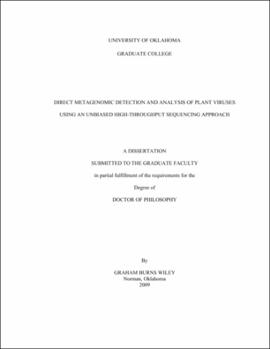| dc.description.abstract | It is well established that plants, along with other life forms, often are infected by viral parasites that require the host cellular machinery for replication. Since the overwhelming majority of these viruses have been from cultivated plants from laboratories and greenhouses, I investigated the viral populations from wild, uncultivated plants, hypothesizing that they would harbor new and novel viruses. To complete this study, an optimized method for the detection of plant viruses using a direct, unbiased metagenomic approach was developed and implemented from plants in the Tallgrass Prairie Preserve in Northeastern Oklahoma. Subsequently, their RNA viral genomes were isolated and converted to tagged cDNAs that were pyrosequenced on a Roche/454 GS-FLX, assembled and compared to other known gene sequences. A comprehensive relational mySQL-based web-accessible database also was implemented to facilitate analysis of the large amounts of metagenomic data generated. Of the 1254 sampled plants, 496 were infected with one or more viruses, that were represented by 1624 assembled cDNA sequences. Of the 19 viral families represented, the three most prevalent were Tymoviridae, Totiviridae, and Partitiviridae although the majority of observed virus sequences were new, previously un-described species, often representing new viral genera. Since Totiviridae and Partitiviridae, characteristically fungal viruses, also coincided with detection of fungi associated with the plants, it is very likely that the majority of the viruses observed represented viral infections of fungi that were interacting with the plants. | |
| dc.description.abstract | Through these studies, a diverse number of new, previously undiscovered viral species were observed in the wild, uncultivated plants of the Tallgrass Prairie Preserve, that multiple infections of viruses in these plants are commonplace, at least one virus, a member of the family Tymoviridae, was widely distributed on a single species of plant, Asclepias viridis,a likely ecological viral niche, and that a majority of the classified viral species observed represented members of fungal associated virus families | |
